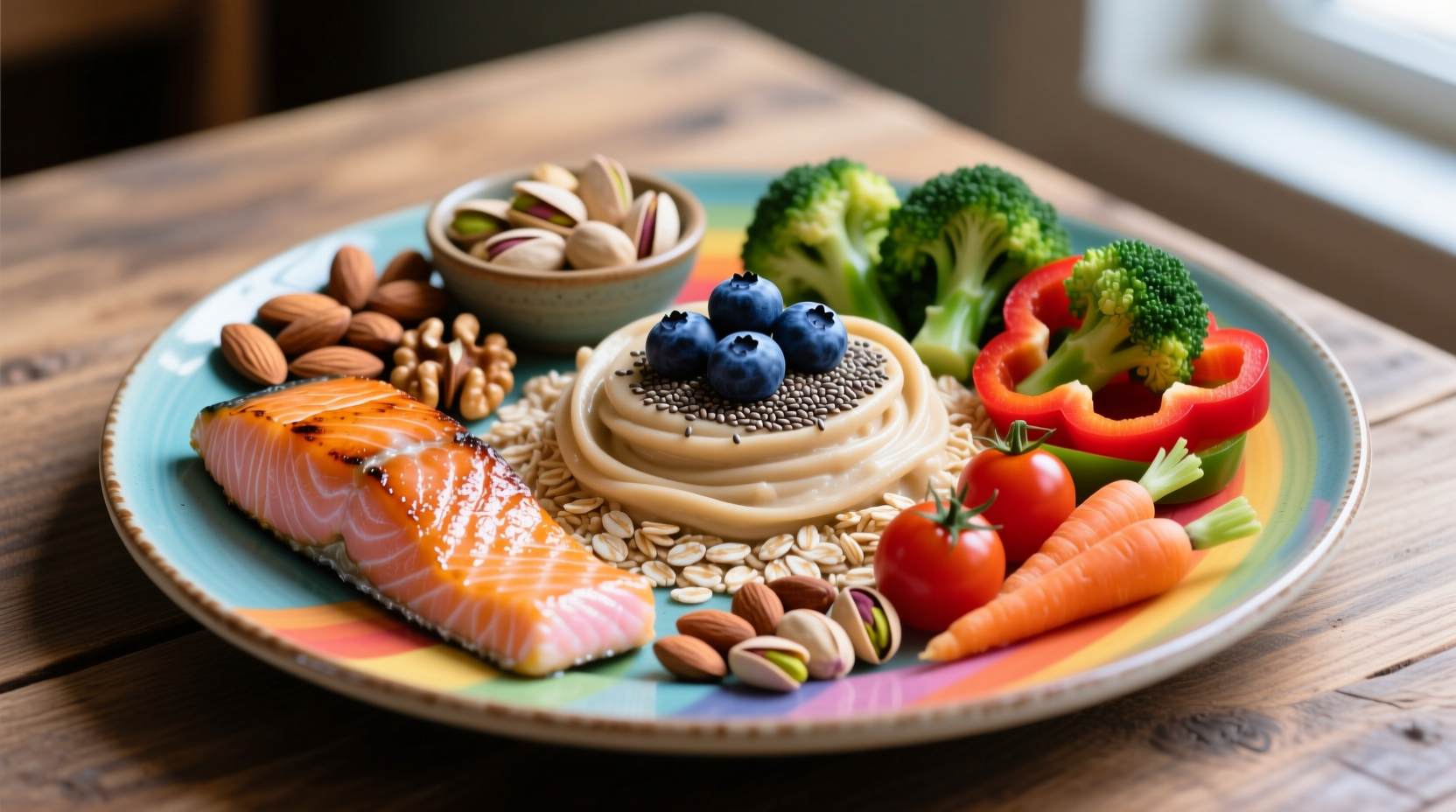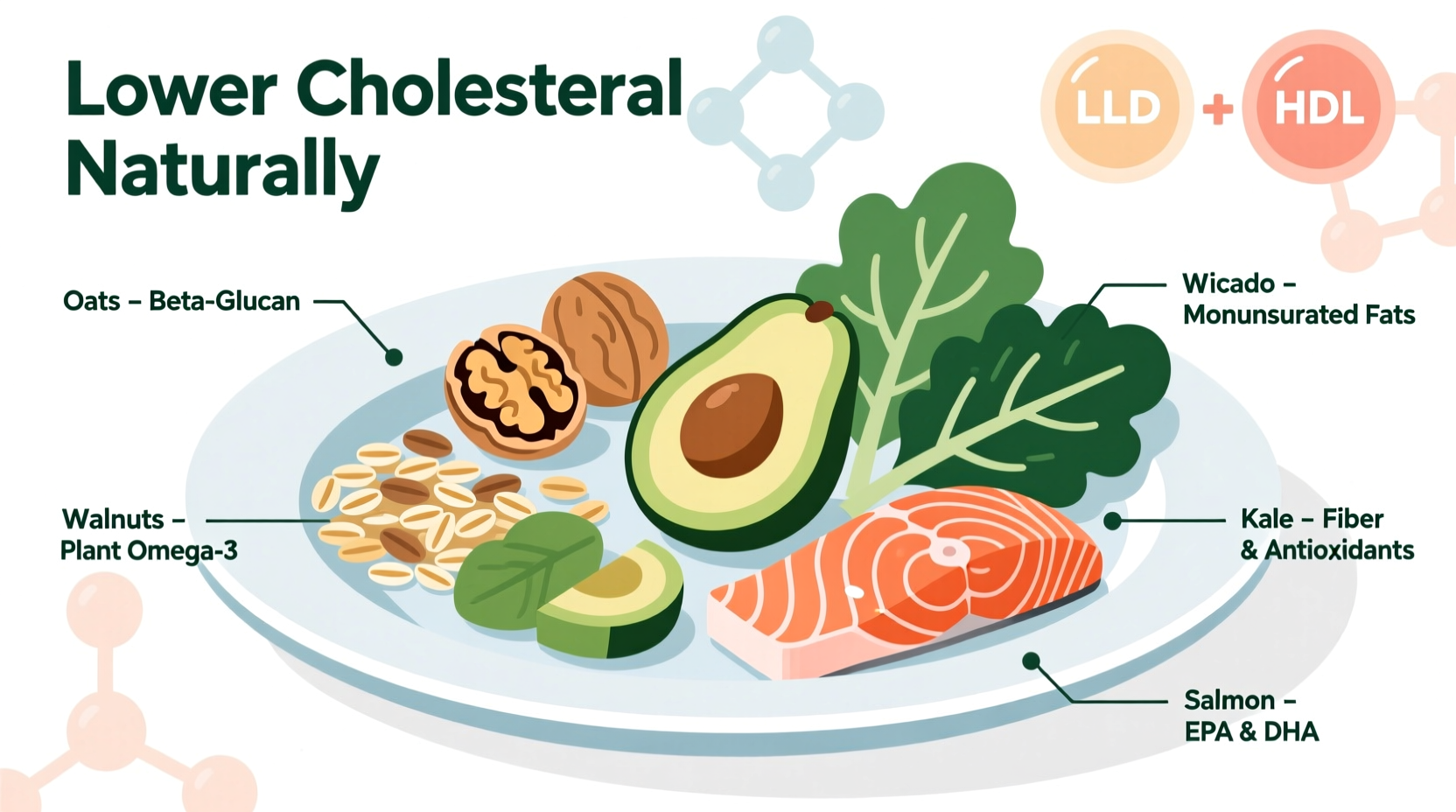The most effective foods that lower cholesterol include oats, fatty fish (like salmon), nuts (especially walnuts and almonds), olive oil, beans and legumes, apples and other fruits rich in pectin, and leafy green vegetables. Consuming these foods regularly as part of a balanced diet can reduce LDL ("bad") cholesterol by 5-15% within 4-12 weeks, according to research from the American Heart Association and National Institutes of Health.
Discover how to strategically incorporate these cholesterol-lowering foods into your daily routine for measurable results. This guide provides evidence-based recommendations from leading medical institutions, practical meal planning strategies, and clear expectations about what dietary changes can realistically achieve for your heart health.
Understanding Cholesterol: What You Need to Know First
Before making dietary changes, understand that cholesterol management involves two key components: reducing LDL (low-density lipoprotein) cholesterol, which contributes to artery-clogging plaque, and maintaining or increasing HDL (high-density lipoprotein) cholesterol, which helps remove LDL from your bloodstream. While genetics play a role, dietary choices significantly impact your cholesterol levels.
According to the American Heart Association, dietary changes alone can reduce LDL cholesterol by up to 15%—comparable to some cholesterol medications. The most effective approach combines multiple cholesterol-lowering foods rather than relying on a single "superfood."
Your Practical Guide to Cholesterol-Lowering Foods
These foods work through various mechanisms: soluble fiber binds cholesterol in your digestive system, healthy fats replace saturated fats, and plant sterols block cholesterol absorption. Here's exactly how to use them:
Oats and Whole Grains: The Fiber Foundation
Start your day with 1.5 cups of cooked oats or other whole grains like barley or quinoa. The soluble fiber in oats, called beta-glucan, can reduce LDL cholesterol by 5-7% when consumed daily. A National Institutes of Health study found that consuming 3 grams of oat beta-glucan daily significantly lowered total and LDL cholesterol.
Fatty Fish: Omega-3 Powerhouse
Include two 3.5-ounce servings of fatty fish weekly. Salmon, mackerel, herring, and sardines provide omega-3 fatty acids that reduce triglycerides and increase HDL cholesterol. The American Heart Association recommends fatty fish over supplements for maximum benefit, as the whole food provides additional nutrients that work synergistically.
Nuts: The Crunchy Cholesterol Fighters
Handfuls of walnuts, almonds, or pistachios (about 1.5 ounces daily) can lower LDL by 5-10%. Research published in the Journal of the American Heart Association shows that regular nut consumption is associated with a 30% lower risk of heart disease. The healthy fats, fiber, and plant sterols in nuts work together to improve cholesterol profiles.
| Food Category | Daily Amount Needed | LDL Reduction Potential | Timeframe for Results |
|---|---|---|---|
| Oats/whole grains | 1.5 cups cooked | 5-7% | 4-6 weeks |
| Nuts | 1.5 ounces | 5-10% | 8-12 weeks |
| Fatty fish | 2 servings/week | 4-6% (triglycerides) | 6-8 weeks |
| Olive oil | 2 tablespoons | 8-10% | 6-12 weeks |
| Beans/legumes | 1/2 cup daily | 5-8% | 6-8 weeks |
Olive Oil: The Heart-Healthy Fat
Replace butter and saturated fats with extra virgin olive oil. Consuming 2 tablespoons daily can lower LDL by 8-10% while preserving HDL levels. The PREDIMED study demonstrated that a Mediterranean diet rich in olive oil reduced cardiovascular events by 30% compared to a low-fat diet.

Beans, Legumes, and Soluble Fiber Powerhouses
Half-cup servings of beans, lentils, or chickpeas daily provide soluble fiber that binds cholesterol in your digestive tract. A meta-analysis in the American Journal of Clinical Nutrition found that consuming one serving of legumes daily reduced LDL cholesterol by 5% and total cholesterol by 4%.
Fruits and Vegetables: Nature's Cholesterol Fighters
Apples, grapes, strawberries, and citrus fruits contain pectin, a type of soluble fiber that lowers cholesterol. Leafy greens like spinach and kale provide lutein, which may help prevent cholesterol from sticking to artery walls. Aim for 4-5 servings daily of these cholesterol-lowering fruits and vegetables for optimal results.
Creating Your Cholesterol-Lowering Meal Plan
Effective cholesterol management requires consistent dietary patterns, not isolated food choices. Here's how to structure your meals:
Morning Routine for Lower Cholesterol
Start with oatmeal topped with sliced apples and walnuts, using almond milk instead of dairy. This combination delivers beta-glucan from oats, pectin from apples, and healthy fats from walnuts—the triple threat against LDL cholesterol. Add a side of grapefruit, which contains compounds that may help lower cholesterol.
Lunch and Dinner Strategies
For lunch, try a large salad with leafy greens, chickpeas, avocado, and olive oil dressing. At dinner, focus on fish or plant-based proteins with plenty of vegetables. The Mediterranean diet pattern—which emphasizes these cholesterol-lowering foods—has been shown to reduce heart disease risk by 25-30% according to research from The New England Journal of Medicine.
What the Research Timeline Reveals About Cholesterol Management
Understanding the evolution of cholesterol research helps contextualize current recommendations:
- 1980s: Research established the link between saturated fats and high cholesterol
- 1990s: Soluble fiber's cholesterol-lowering effects were documented in multiple studies
- 2000s: Plant sterols and stanols were recognized as effective cholesterol reducers
- 2010s: Focus shifted to overall dietary patterns rather than single nutrients
- 2020s: Personalized nutrition approaches based on genetic factors are emerging
This progression shows why current recommendations emphasize whole dietary patterns rather than isolated "cholesterol-busting" foods. The most effective approach combines multiple cholesterol-lowering foods within a balanced eating pattern.
Important Context: When Diet Alone Isn't Enough
While these dietary strategies work for many people, certain situations require additional approaches:
- Genetic conditions like familial hypercholesterolemia often need medication alongside diet
- Individuals with existing heart disease may require more aggressive treatment
- Results vary based on baseline cholesterol levels and overall health
- Dietary changes typically reduce LDL by 5-15%, while medications can achieve 30-60% reductions
The American Heart Association emphasizes that dietary changes should complement—not replace—medical treatment when prescribed. Always consult your healthcare provider before making significant dietary changes, especially if you have existing health conditions or take cholesterol-lowering medications.
Maximizing Your Results: Beyond Individual Foods
For the best outcomes, combine these cholesterol-lowering foods with other heart-healthy habits:
- Regular physical activity (150 minutes weekly of moderate exercise)
- Maintaining a healthy weight
- Avoiding trans fats completely
- Limited alcohol consumption
- Stress management techniques
Remember that consistency matters more than perfection. Small, sustainable changes that you can maintain long-term will yield better results than drastic short-term diets. Most people see measurable improvements in cholesterol levels within 8-12 weeks of consistent dietary changes.
Frequently Asked Questions
How quickly can I expect to see results from eating cholesterol-lowering foods?
Most people see measurable improvements in LDL cholesterol levels within 4-12 weeks of consistently incorporating these foods into their diet. The American Heart Association notes that dietary changes typically reduce LDL by 5-15%, with maximum benefits appearing around 8-12 weeks. Individual results vary based on baseline levels, overall diet quality, and genetic factors.
Do I need to eliminate all high-cholesterol foods like eggs?
Current research shows that for most people, dietary cholesterol from foods like eggs has less impact on blood cholesterol than saturated and trans fats. The 2020-2025 Dietary Guidelines for Americans removed specific limits on dietary cholesterol, focusing instead on limiting saturated fats. Most healthy people can consume one egg daily without negatively affecting cholesterol levels, but those with diabetes or existing heart disease should consult their healthcare provider.
Can I still eat meat while trying to lower my cholesterol?
Yes, but you'll need to make strategic choices. Opt for lean cuts of poultry and meat, remove visible fat, and limit portions to 3-4 ounces per serving. The Mediterranean diet pattern—which includes moderate amounts of poultry and limited red meat—has been shown to improve cholesterol levels. Consider replacing some meat meals with plant-based proteins like beans, lentils, and fatty fish for optimal cholesterol management.
Are cholesterol-lowering foods effective for everyone?
While most people benefit from these dietary approaches, individual responses vary significantly due to genetic factors. About 15-25% of the population are "hyper-responders" who experience greater cholesterol changes from dietary modifications. Those with genetic conditions like familial hypercholesterolemia often require medication alongside dietary changes. If you don't see expected improvements after 12 weeks of consistent dietary changes, consult your healthcare provider.
How do cholesterol-lowering foods compare to medication?
Dietary changes typically reduce LDL cholesterol by 5-15%, while statin medications can achieve 30-60% reductions. The American Heart Association recommends using diet as a foundation for cholesterol management, with medication added when necessary based on individual risk factors. Some people can manage cholesterol effectively with diet alone, while others need both approaches. Never stop prescribed medication without consulting your healthcare provider.











 浙公网安备
33010002000092号
浙公网安备
33010002000092号 浙B2-20120091-4
浙B2-20120091-4